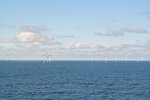News Release from WindEurope
Wind Industry Profile of
01/17/2011
EWEA - Serbia's Wind Energy resources are considerable
Currently, 34% of Serbia's total capacity is hydro with coal being the traditional energy source. The report continues to say that wind power is expected to become a significant part of the renewable energy portfolio in Serbia in the future but the first 6 MW of installed wind farm capacity is not scheduled to become operational until the end of 2011.
That figure is expected to grow to about 100 MW by the end of 2012. According to Serbia’s ministry of mining and energy, the country’s total estimated wind power capacity to be connected to the system is 1,300 MW, approximately 15% of the nation’s total capacity.
Ministry documents show locations in the northeastern part of the country have a high wind potential based on wind speeds. Other locations potentially suitable for wind energy development include Midzor, Suva Mt., Vrsacki Breg, Tupiznica, Krepoljin and Deli Jovan.
Oil, gas and coal are among the natural resources of Serbia, which has a population of about 7.4 million people living in its 77,500 km2. Serbia’s ministry of mining and energy has noted that in 2007 the nation consumed 15 million tonnes of oil equivalents (Mtoe), of which 6.14 Mtoe — or roughly 40% — were imported. It is worth noting that coal accounted for 54% of the Mtoe total, followed by oil at 27% and gas at 13%.
The ministry also said that “Serbia’s endowment of renewable energy resources ‘RES’ is considerable, around 4.89 Mtoe potential in the long term (only 17.6% of this potential is currently used by hydro power plants).”
The ministry document added all of the renewable energy in the country (9.928 GWh in 2007) was produced by hydro power plants, representing 24.9% of Serbian electricity consumption.“The Energy Development Strategy anticipates efforts to improve energy efficiency and the use of renewable sources, enacting i nancial and non_i nancial incentive policies and implementation of investment projects,” the document says.
Energy infrastructures and power generation facilities are totally controlled by the Government of Serbia through two public companies: “Elektromreza Srbije“ (EMS or EMC), the only market operator, and “Elektroprivreda Srbije” (EPS), the only power producer.
The document says EPS accounts for a net installed capacity of 8,359 MW, of which 62% corresponds to thermal power plants, 34% to hydro power plants and the remaining to combined heat plants. The regulatory framework designed to increase the use of renewable energy sources is based on the adaption of the current Energy Law. Amendments will allow so-called Privileged Power Producers, such as wind energy, to have priority in grid connection, access to feed-in tariffs representing €95 per MWh, standardised power purchase agreements and various tax incentive.
For more information on this article or if you would like to know more about what www.windfair.net can offer, please do not hesitate to contact Trevor Sievert at ts@windfair.net
www.windfair.net is the largest international B2B Internet platform – ultimately designed for connecting wind energy enthusiasts and companies across the globe!
That figure is expected to grow to about 100 MW by the end of 2012. According to Serbia’s ministry of mining and energy, the country’s total estimated wind power capacity to be connected to the system is 1,300 MW, approximately 15% of the nation’s total capacity.
Ministry documents show locations in the northeastern part of the country have a high wind potential based on wind speeds. Other locations potentially suitable for wind energy development include Midzor, Suva Mt., Vrsacki Breg, Tupiznica, Krepoljin and Deli Jovan.
Oil, gas and coal are among the natural resources of Serbia, which has a population of about 7.4 million people living in its 77,500 km2. Serbia’s ministry of mining and energy has noted that in 2007 the nation consumed 15 million tonnes of oil equivalents (Mtoe), of which 6.14 Mtoe — or roughly 40% — were imported. It is worth noting that coal accounted for 54% of the Mtoe total, followed by oil at 27% and gas at 13%.
The ministry also said that “Serbia’s endowment of renewable energy resources ‘RES’ is considerable, around 4.89 Mtoe potential in the long term (only 17.6% of this potential is currently used by hydro power plants).”
The ministry document added all of the renewable energy in the country (9.928 GWh in 2007) was produced by hydro power plants, representing 24.9% of Serbian electricity consumption.“The Energy Development Strategy anticipates efforts to improve energy efficiency and the use of renewable sources, enacting i nancial and non_i nancial incentive policies and implementation of investment projects,” the document says.
Energy infrastructures and power generation facilities are totally controlled by the Government of Serbia through two public companies: “Elektromreza Srbije“ (EMS or EMC), the only market operator, and “Elektroprivreda Srbije” (EPS), the only power producer.
The document says EPS accounts for a net installed capacity of 8,359 MW, of which 62% corresponds to thermal power plants, 34% to hydro power plants and the remaining to combined heat plants. The regulatory framework designed to increase the use of renewable energy sources is based on the adaption of the current Energy Law. Amendments will allow so-called Privileged Power Producers, such as wind energy, to have priority in grid connection, access to feed-in tariffs representing €95 per MWh, standardised power purchase agreements and various tax incentive.
For more information on this article or if you would like to know more about what www.windfair.net can offer, please do not hesitate to contact Trevor Sievert at ts@windfair.net
www.windfair.net is the largest international B2B Internet platform – ultimately designed for connecting wind energy enthusiasts and companies across the globe!
- Source:
- EWEA
- Author:
- Posted by Trevor Sievert, Online Editorial Journalist
- Email:
- ewea@ewea.org
- Link:
- www.ewea.org/...
- Keywords:
- ewea, wind energy, wind power, wind turbine, onshore, offshore, windmill, www.windfair.net, Trevor Sievert, ECA




























